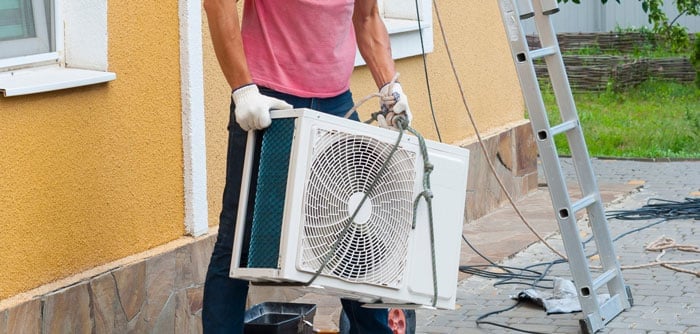We've independently reviewed this article to make sure it's as accurate as we can make it.
To find out more about our article creation and review process, check out our editorial guidelines.
If you’ve done much reading about how to cut energy costs and cool your home better, you might have seen advice to moving your air conditioner unit.

And your first thought was, “let me get right on that,” right?
Probably not. Because you probably, and rightfully, guessed that doing it is more difficult than it sounds.
There are a few main reasons why an air conditioner unit shouldn’t be moved by a homeowner. Safety and the law. Your AC has refrigerant, which is dangerous. It’s illegal for someone uncertified to handle it. Also, there are municipal laws about the placement of the unit.
Read on, and I’ll cover possible reasons for moving an air conditioner and what’s involved.
What’s Involved in Moving an Air Conditioning Unit?
To start with, let’s stick to moving central air units. Briefly, here are some of the things that need to be considered.
- The refrigerant line
- It’s weight
- Municipal laws regarding their placement
- Rewiring the thermostat
Breaking the above down, you’ll see this is not a DIY project!
The Refrigerant Line
In the western world at least, you need to be certified to be able to purchase or handle refrigerant.
- In the US you need to have an EAP Section 608 Certification
- In the UK, you need to have F-Gas Certification
- Canada has regulations at the provincial level. For example, in Ontario, ODP Certification is required.
So unless you have certification, you’re not legally allowed to handle refrigerant.
Weight
I’m not going to say no one would be able to lift a central air unit because I’m sure some can. But here’s an idea of what they might weigh.
Central Air Conditioner Condensers
| Size in Tons | Weight |
| 1.5 Ton | 131 lbs / 59.5 kgs |
| 2 Ton | 142 lbs / 64.4 kgs |
| 2.5 Ton | 154 lbs / 69.9 kgs |
| 3 Ton | 181 lbs / 82.1 kgs |
| 3.5 Ton | 304 lbs / 137.9 kgs |
| 4 Ton | 304 lbs / 137.9 kgs |
| 5 Ton | 321 lbs / 145.6 kgs |
Most people won’t be able to lift one of the bigger units by themselves, even just to get it onto a hand truck.
Municipal Laws Regarding Placement
Many municipalities will have laws around the placement of your unit, so even if you could move it by yourself, you can’t just plop it back down wherever you want.
Some cities and towns say you can’t install in front of your home. You could put it in the back, but then you have to talk over the roar of it while entertaining on the back deck. Which leaves the side of the house. Except, there are zoning laws that stipulate the unit has to be a certain amount away from the property line.
In the typical suburban neighborhood where houses are 5 feet away from each other, this presents something of a conundrum!
Rewiring the Thermostat
While we’re about to dive into the rewiring process, most modern systems will run with a wireless thermostat – which is a heck of a lot easier to install and relocate!
Rewiring the thermostat could be done by someone handy, but I’m guessing it’s not a job most people would want to tackle.

However, here are the steps. Just note beforehand that you will need to run wires from your outdoor unit to your indoor unit, and then from your indoor unit to the new thermostat location.
1. Before you do anything, cut power to the thermostat at the circuit breaker. The thermostat’s power is supplied from the indoor air conditioner unit, so switch off that circuit to disconnect. (If it’s a minisplit, you’ll need to cut off the outdoor unit’s power too – as it may power the whole system).
2. Remove the faceplate from the thermostat and disconnect the wires
3. Take the back panel off the wall
4. Mark a spot on the wall where you’re relocating and then drill a hole
5. Attach the back panel to your new location
6. Pull your fished wires through the hole you just drilled
7. Reconnect the wiring to your thermostat’s interface
Now you know what’s involved in moving an air conditioner, but under what circumstances should you consider moving it? When is going to all the work and the cost—and I’ll get to the cost below—of moving it worth the effort?
Reasons to Move an Air Conditioning Unit
There are several very good reasons to relocate your air conditioner’s condenser.

One reason many choose to relocate their air conditioner is to get it out of the sun. But it turns out this advice is somewhat controversial. Many HVAC companies say that shading your AC can make it run about 10% more efficiently.
Bob Vila’s site claims, “shading your air conditioner can reduce energy costs by as much as 50 percent.”
But a third site says that neither of those claims is true and that they are nothing more than a myth. With some pretty credible sources to back that claim up.
So if you’re thinking about relocating to save on energy costs, do some more research first.
Here are some other reasons for wanting to move your air conditioner.
You Hate the Look of Where It Is Now
There’s a good chance you might have inherited someone else’s choice on placement when you bought the house. If your property allows for it, you may want to move it.
Making Room for a Home Addition
If you want to add a room to your home, you don’t have to work around the existing location of your air conditioner. In fact, a home reno like this would be a great time to move it.
Noise Reduction
Despite claims of quiet AC units—and yes, some are quieter than others—they all make constant, considerable noise. So having one right beside your patio or under your bedroom window might be more than you can stand.
New Deck, Patio, or Porch
Many air conditioners are situated at the back of the house. But if you’ve decided it’s time for a deck or patio, your AC might be in the way. Or it might not be in the way but still too close for comfort noise-wise.
Code Compliance
I talked above about municipal codes that dictate where your AC condenser can or can’t be located. What if you went ahead and put it wherever you wanted, and your neighbor complained? Then you have an inspector from your city or town there telling you about the fine you’ll get if you don’t move it.
How Much Will It Cost to Move an Air Conditioner?
First of all, remember the outside unit needs to be moved as well as your thermostat.
Cost to Move Condenser (The Outside Unit)
There are a lot of variables here so it’s impossible to quote an exact cost. To get that, you’d need to call an HVAC pro in your area.
The max price I’ve seen an HVAC website mention is $1,000 to move your AC. This was in the Phoenix, Az area.
Also coming in at $1,000 moving the AC about 10 feet to the other side of the house in the Toronto area. However, this was about 5 years ago, so you can bet it’s much more now.
I stumbled across a Reddit thread that’s two years old, where a homeowner was quoted about $900 to move his AC 25 feet. Everyone agreed that that quote was very low.
However, I have seen mention of quotes in the $400 to $600 range, so again. You need to contact someone locale for a quote.
Cost to Relocate Your Thermostat
Just like in the case of your air conditioner, there are several variables that will impact the cost of moving a thermostat. These include:
- The distance you’re moving it
- The cost to patch the drywall at the current location and cut a hole for the new location
- Wire installation (running to the new location)
Here are some estimates.
| Labor | Estimate |
| Relocate 10 feet away | $135 – $250 |
| Relocate 20 feet away | $195 – $350 |
| Relocate 30 feet away | $255 – $450 |
Note that where you live will impact pricing, so check with someone locally.
Conclusion
Clearly, moving your air conditioner and thermostat isn’t going to be cheap. But there are valid reasons for wanting it done. Although we have learned that there is some controversy around the advantage of moving your condenser to a shadier spot.
Other than that, reasons for moving it may include:
- You don’t like its current location
- You’re building an addition
- You want to reduce noise
- You’re planning a patio or deck
- You need to move it to a compliant location
Depending on several factors, it could cost you close to $1,500 to move your air conditioner and thermostat.
But remember, check your local prices!
Thanks for reading. Why not check out our related posts below?







